![]()
![]()
![]()
Use LEFT and RIGHT arrow keys to navigate between flashcards;
Use UP and DOWN arrow keys to flip the card;
H to show hint;
A reads text to speech;
40 Cards in this Set
- Front
- Back
|
What is the middle layer of the skin? What is it derived from?
|
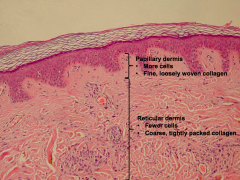
Dermis - mesoderm
|
|
|
What is the function of the dermis?
|
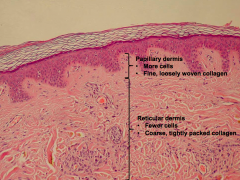
- Structure and flexibility
- Vascular support - Immunologic protection - Nerve sensation - Adnexal structures: hair follicles, eccrine (sweat) glands, sebaceous (oil) glands |
|
|
What are the layers of the Dermis?
|
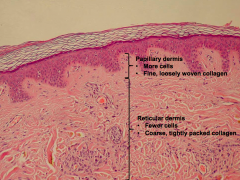
- Papillary dermis (superficial)
- Reticular Dermis (deep) |
|
|
What is the difference between Papillary Dermis vs. Reticular Dermis?
|
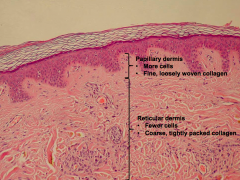
- Papillary - more superficial, more cells, fine / loosely woven collagen, interdigitates w/ rete ridges of epidermis
- Reticular - deeper, fewer cells, coarse / tightly packed collagen |
|
|
What is the main component of the dermis? Function?
|
Extracellular Matrix
- Scaffold that gives dermis its structure and function - Regulates cell functions such as adhesion, migration, division, and apoptosis - Important for development, wound healing, tumorigenesis, and inflammation |
|
|
What are the components of the Extracellular Matrix in the dermis?
|
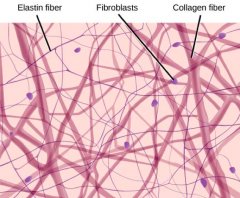
- Collagen
- Elastic fibers - Extrafibrillar matrix |
|
|
What amount of the overall skin volume is collagen? What amount of the dry weight of the skin is collagen?
|

- Overall: 20%
- Dry weight: 75% |
|
|
What produces the collagen in the dermis?
|
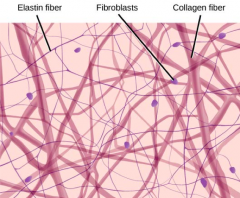
Dermal fibroblasts
|
|
|
How many types of collagen are in the skin?
|
12 of 28:
- Type 1 - most abundant (80-90%) - Type 3 - second most abundant, increases during embryogenesis and wound healing - Types 4, 7, and 17 (aka BP180) found in BM zone |
|
|
What are the properties of collagen in the skin?
|
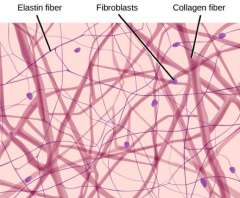
- Very strong
- Stretches very little |
|
|
What are the function and structure of elastic fibers int he dermis?
|
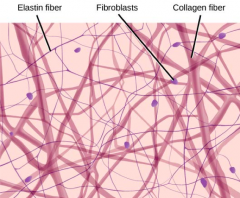
- Give skin elasticity
- Made of microfibrils (fibrillin and amorphous elastin) |
|
|
What is the ground substance made of in the ECM?
|
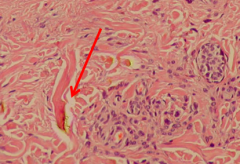
AKA extrafibrillar matrix:
- Water - Electrolytes - Plasma proteins - Proteoglycans, glycoproteins, hyaluronic acid |
|
|
What are the types of cells in the dermis?
|
- Fibroblasts (predominant cells of dermis)
- Macrophages, mast cells, other immune cells - Endothelial cells - Nervous tissue |
|
|
What are fibroblasts derived from? What do they do?
|
- Derived from mesoderm
- Synthesize ECM components: collagen, elastic fibers, ground substance |
|
|
What is the blood vessel organization in the dermis? Functions?
|
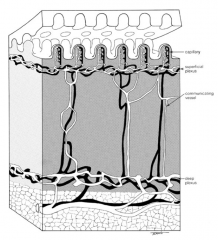
- Superficial plexus in papillary dermis
- Deep plexus in reticular dermis - Capillaries emanate from these structures to supply the dermis - Nutrition/circulation, temperature regulation, leukocyte trafficking, and wound healing |
|
|
Where do nerves run in the dermis? Functions?
|
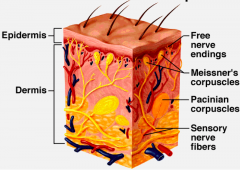
- Course along the superficial and deep vascular plexuses
- Autonomic motor nerves innervate endothelial cells to control tone, smooth muscles of hair follicle to control pilomotor response, and eccrine glands to mediate sweating - Somatic sensory nerves detect light touch, discriminative touch, pressure, temperature, pain, itch, vibration, and proprioception |
|
|
What are the touch and pressure receptors we need to know?
|
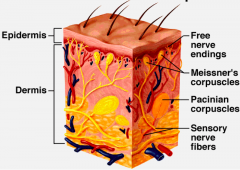
- Pacinian corpuscles - weight-bearing surfaces, as well as lips, nipples, penis, and clitoris (deep dermis and subcutaneous tissue) = Detect Pressure
- Meissner's corpuscles - located below epidermis in dermal papillae, concentrated in palms and soles = Detect Light Touch |
|
|
What are the diseases of the dermis?
|
- Marfan Syndrome
- Ehlers-Danlos Syndrome - Morphea (localized scleroderma) - Systemic Sclerosis |
|
|
How is Marfan Syndrome acquired? What is the cause?
|
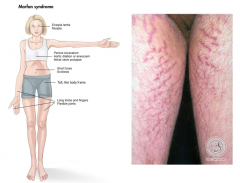
- Autosomal dominant
- Mutation in fibrillin - Variable expression |
|
|
What are the common features of Marfan Syndrome?
|
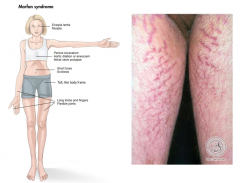
- Tall and thin body type
- Long limbs and fingers - Scoliosis - Flexible joints - Striae (stretch marks) - Nearsightedness (myopia) - Ectopia lentis (dislocation of lens of eye) - Aortic dilation or aneurysm - Mitral valve prolapse |
|
|
How is Ehlers-Danlos Syndrome acquired? What is the cause?
|

- Inherited connective tissue disorder (variable inheritance)
- Abnormality in collagen structure, production, processing, or assembly |
|
|
What are the common features of Ehlers-Danlos Syndrome?
|
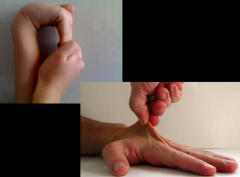
- Fragile skin (very elastic and prone to scarring)
- Extremely flexible joints - may cause joint dislocations or early arthritis - Severe scoliosis - curvature of spine may affect breathing - Rupture of blood vessels, intestines and uterus in some types |
|
|
How is Morphea (localized scleroderma) acquired? What is the cause?
|

- Acquired autoimmune disease
- Thickening of collagen (sclerosis) - Children and adults, females > males |
|
|
What are the common features of Morphea?
|
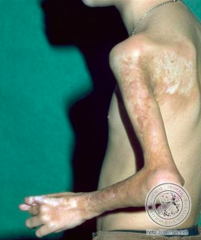
- Sclerosis
- Erythematous and indurated plaques that slowly expand (violaceous plaques and sclerotic plaques) - Fibrotic or atrophic scars - Joint and neurologic complications (not as bad internal organ involvement) - may not be able to move joints d/t sclerosis |
|
|
How is Systemic Sclerosis acquired? What is the cause?
|
- Autoimmune disease
- Affects middle-aged women especially - Widespread sclerosis |
|
|
What are the two types of Systemic Sclerosis?
|
- Limited Systemic Sclerosis (formerly called CREST syndrome)
- Diffuse Systemic Sclerosis |
|
|
What are the common features of Limited Systemic Sclerosis?
|
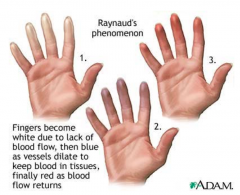
CREST Syndrome:
- Calcinosis cutis - calcium deposits in skin - Raynaud phenomenon - fingers turn white d/t lack of blood flow, then blue as vessels dilate, then red as flood flow returns (white-blue-red) - Esophageal dysmotility - Sclerodactyly (thickening and tightening of skin of fingers) - Telangiectasia of face (small broken capillaries on skin surface) (also microstomia - pinched mouth in some) |
|
|
What is the subcutaneous fat derived from? What are its functions?
|
- Derived from mesoderm
- Energy storage, insulation, and shock absorption |
|
|
What are the main cells of the subcutaneous fat? Functions?
|
Adipocytes - synthesize and store lipids in cytoplasm
|
|
|
How are adipocytes arranged?
|
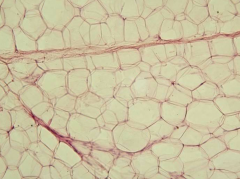
- Adipocytes aggregate in lobules
- Fibrous bands called septae or trabeculae separate the lobules - Septae contain blood vessels and nerves |
|
|
What are the disorders of the subcutaneous fat?
|
- Inflammation = Panniculitis
- Erythema Nodosum |
|
|
What is panniculitis?
|
Inflammation of the subcutaneous fat
|
|
|
What is the most common type of panniculitis (inflamed subcutaneous fat)? Who is most likely to get this?
|
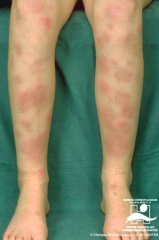
Erythema Nodosum (EN)
- More common in young women (maybe d/t contraception) - Can affect people of any age, sex, or race |
|
|
What commonly causes Erythema Nodosum?
|
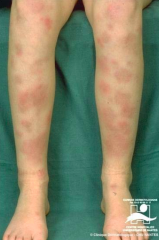
- Reactive process that can be triggered by a variety of factors
- Most times idiopathic - Infectious causes most common (especially upper respiratory streptococcal infection) - Medications (especially oral contraceptives), sarcoidosis, inflammatory bowel disease, and malignancy can also trigger |
|
|
What are the common features of Erythema Nodosum?
|
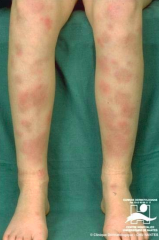
- Tender, red nodules that arise on shins
- May arise in crops, then slowly involute over course of a few days or weeks |
|
|
What disease is characterized by the following symptoms?
- Tall and thin body type w/ long thin limbs and fingers - Flexible joints - Scoliosis - Striae (stretch marks) - Nearsightedness and ectopia lentis (dislocation of lens) - Aortic dilation or aneurysm - Mitral Valve prolapse What is the cause? |
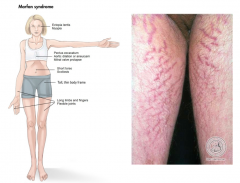
- Marfan Syndrome
- Autosomal dominant d/t mutations in fibrillin --> connective tissue disorder |
|
|
What disease is characterized by the following symptoms?
- Extremely flexible joints - Fragile skin - Joint dislocations and early arthritis - Severe scoliosis - Rupture of blood vessels, intestines, and uterus possible What is the cause? |

- Ehlers-Danlos Syndrome
- Mutations in structure, production, processing, or assembly of collagen |
|
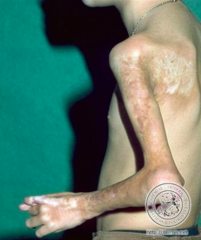
What disease is characterized by the following symptoms?
- Thickening of collagen - Erythematous indurated plaques that slowly expand - Even w/ treatment may leave fibrotic or atrophic scars - Some joint and neurologic complications What is the cause? |
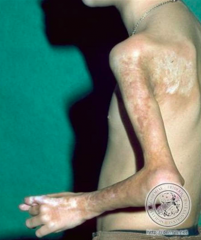
- Morphea (localized scleroderma)
- Acquired autoimmune disease |
|
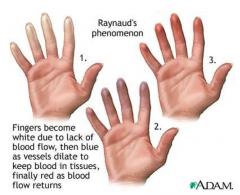
What disease is characterized by the following symptoms?
- CREST syndrome - Calcinosis cutis - Raynaud phenomenon - Esophageal dysmotility - Sclerodactyly - Telangiectasia - Pulmonary fibrosis, renal failure, GI disease, and cardiac disease What is the cause? |
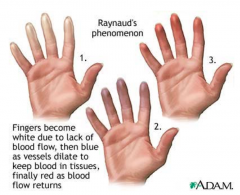
Systemic Sclerosis (specifically limited type)
- Acquired autoimmune disease |
|
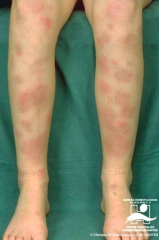
What disease is characterized by the following symptoms?
- Tender red nodules on shins - May arise in crops that involute over the course of a few days to weeks What is the cause? |

Erythema Nodosum
- Acquired disorder - Triggered most commonly by upper respiratory streptococcal infection - Other triggers: meds (oral contraceptives), sarcoidosis, IBD, and malignancy |

